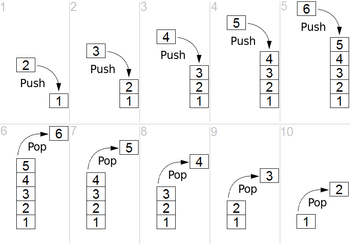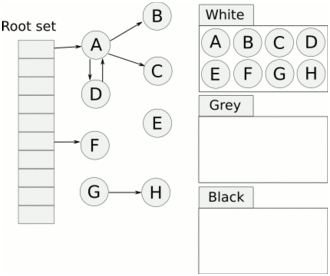Gocontrol Thermstat Gc-tbz48l Fan Starts Then Stops Then Starts Again
An overview of memory management in Become
As programs run they write objects to retention. At some point these objects should be removed when they're non needed anymore. This process is called memory management. This commodity aims to requite an overview of memory management, and then dive deeper into how this is implemented in Get past using a garbage collector. Go has seen many changes to its memory management over the years, and will most probable encounter more in the future. If you're reading this and you're using a version of Go afterward than 1.xvi, some of this information may be outdated.
Manual Memory Direction
In a language similar C the programmer will call a function such as malloc or calloc to write an object to retentiveness. These functions return a pointer to the location of that object in heap retention. When this object is non needed anymore, the developer calls the free function to apply this chunk of memory again. This method of memory management is called explicit deallocation and is quite powerful. It gives the programmer greater control over the retentivity in apply, which allows for some types of easier optimisation, particularly in low retention environments. However, it leads to ii types of programming errors.
One, calling free prematurely which creates a dangling pointer. Dangling pointers are pointers that no longer bespeak to valid objects in memory. This is bad because the programme expects a defined value to alive at a pointer. When this arrow is afterwards accessed there's no guarantee of what value exists at that location in memory. There may be nothing there, or another value entirely. Two, failing to gratis memory at all. If the developer forgets to gratis an object they may face a memory leak as memory fills upwardly with more and more objects. This can atomic number 82 to the programme slowing down or crashing if it runs out of memory. Unpredictable bugs tin can be introduced into a program when retentivity has to be explicitly managed.
Automatic Memory Management
This is why languages like Go offer automatic dynamic memory management, or more than simply, garbage drove. Languages with garbage collection offer benefits like:
- increased security
- better portability across operating systems
- less code to write
- runtime verification of code
- bounds checking of arrays
Garbage drove has a performance overhead, but information technology isn't as much as is often assumed. The tradeoff is that a programmer can focus on the business logic of their program and ensure it is fit for purpose, instead of worrying about managing retention.
A running program will store objects in two retentiveness locations, the heap and the stack. Garbage collection operates on the heap, not the stack. The stack is a LIFO data construction that stores function values. Calling another function from within a function pushes a new frame onto the stack, which will incorporate the values of that office and so on. When the called office returns, its stack frame is popped off the stack. You lot might be familiar with the stack from when you're debugging a crashed plan. Most language compilers will return a stack trace to aid in debugging, which displays the functions that have been chosen leading up to that point.

In contrast, the heap contains values that are referenced outside of a function. For example, statically defined constants at the showtime of a program, or more complex objects, like Get structs. When the programmer defines an object that gets placed on the heap, the needed corporeality of memory is allocated and a arrow to information technology is returned. The heap is a graph where objects are represented as nodes which are referred to in code or by other objects in the heap. Equally a program runs, the heap volition go along to grow as objects are added unless the heap is cleaned up.

Garbage Collection in Go
Go prefers to allocate retentiveness on the stack, so most retentivity allocations will end up at that place. This ways that Go has a stack per goroutine and when possible Go will classify variables to this stack. The Go compiler attempts to prove that a variable is not needed outside of the function by performing escape analysis to run into if an object "escapes" the office. If the compiler tin can make up one's mind a variables lifetime, it will exist allocated to a stack. However, if the variable's lifetime is unclear it will be allocated on the heap. Generally if a Go plan has a pointer to an object then that object is stored on the heap. Take a await at this sample code:
type myStruct struct { value int }
var testStruct = myStruct{value: 0}
func addTwoNumbers(a int, b int) int { return a + b }
func myFunction() { testVar1 := 123 testVar2 := 456 testStruct.value = addTwoNumbers(testVar1, testVar2) }
func someOtherFunction() { // another code myFunction() // some more lawmaking }
For the purposes of this example, let's imagine this is role of a running program because if this was the whole program the Become compiler would optimise this past allocating the variables into stacks. When the plan runs:
1. testStruct is divers and placed on the heap in an bachelor cake of memory.
ii. myFunction is executed and allocated a stack while the function is existence executed. testVar1 and testVar2 are both stored on this stack.
3. When addTwoNumbers is called a new stack frame is pushed onto the stack with the 2 function arguments.
4. When addTwoNumbers finishes execution, it'south event is returned to myFunction and the stack frame for addTwoNumbers is popped off the stack as it's no longer needed.
5. The pointer to testStruct is followed to the location on the heap containing it and the value field is updated.
six. myFunction exits and the stack created for it is cleaned upward. The value for testStruct stays on the heap until garbage collection occurs.
testStruct is now on the heap and without analysis, the Get runtime doesn't know if information technology's still needed. To do this, Go relies on a garbage collector. Garbage collectors have two key parts, a mutator and a collector. The collector executes garbage drove logic and finds objects that should accept their retentiveness freed. The mutator executes awarding code and allocates new objects to the heap. It also updates existing objects on the heap as the program runs, which includes making some objects unreachable when they're no longer needed.

The implementation of Become's garbage collector
Go's garbage collector is a non-generational concurrent, tri-colour marking and sweep garbage collector. Let's suspension these terms down.
The generational hypothesis assumes that short lived objects, like temporary variables, are reclaimed most oft. Thus, a generational garbage collector focuses on recently allocated objects. However, as mentioned earlier, compiler optimisations allow the Go compiler to classify objects with a known lifetime to the stack. This means fewer objects will be on the heap, then fewer objects volition exist garbage nerveless. This means that a generational garbage collector is not necessary in Go. So, Go uses a non-generational garbage collector. Concurrent means that the collector runs at the same time equally mutator threads. Therefore, Go uses a not-generational concurrent garbage collector. Marker and sweep is the type of garbage collector and tri-color is the algorithm used to implement this
A mark and sweep garbage collector has two phases, unsurprisingly named marker and sweep. In the mark stage the collector traverses the heap and marks objects that are no longer needed. The follow-up sweep stage removes these objects. Mark and sweep is an indirect algorithm, as it marks alive objects, and removes everything else.

Become implements this in a few steps:
Go has all goroutines accomplish a garbage collection safe point with a process called stop the world. This temporarily stops the program from running and turns a write barrier on to maintain data integrity on the heap. This allows for concurrency by allowing goroutines and the collector to run simultaneously.
One time all goroutines have the write barrier turned on, the Get runtime starts the globe and has workers perform the garbage drove work.
Marking is implemented by using a tri-color algorithm. When mark begins, all objects are white except for the root objects which are grey. Roots are an object that all other heap objects come up from, and are instantiated every bit part of running the program. The garbage collector begins marking by scanning stacks, globals and heap pointers to sympathize what is in utilize. When scanning a stack, the worker stops the goroutine and marks all found objects grey past traversing downward from the roots. It and so resumes the goroutine.
The greyness objects are then enqueued to be turned black, which indicates that they're withal in use. In one case all grey objects accept been turned black, the collector will stop the world over again and clean up all the white nodes that are no longer needed. The program tin can now continue running until it needs to make clean up more retentivity again.

This process is initiated again in one case the program has allocated extra memory proportional to the memory in utilize. The `GOGC` environment variable determines this, and is set to 100 by default. The Go source code describes this equally:
If GOGC=100 and we're using 4M, we'll GC once again when we get to 8M (this mark is tracked in next_gc variable). This keeps the GC cost in linear proportion to the allocation price. Adjusting GOGC simply changes the linear constant (and also the corporeality of extra memory used).
Go's garbage collector improves your efficiency by abstracting memory direction into the runtime and is one role of what enables Go to be so performant. Get has congenital in tooling to allow you lot to optimise how garbage drove occurs in your plan that y'all can investigate if you lot're interested. For now, I hope you learnt a bit more well-nigh how garbage collection works and how it'southward implemented in Become.
References
Garbage Collection in Go: Part ane
Getting to Get: The Journey of Become'south Garbage Collector
Go: How Does the Garbage Collector Marker the Retention?
Golang: Cost of using the heap
Golang FAQ
Google Groups give-and-take, annotate by Ian Lance Taylor
Implementing memory management with Golang's garbage collector
Memory Management Reference
Stack (abstract data type)
The Garbage Collection Handbook
Tracing garbage collection: Tri-color marking
Source: https://medium.com/safetycultureengineering/an-overview-of-memory-management-in-go-9a72ec7c76a8
Belum ada Komentar untuk "Gocontrol Thermstat Gc-tbz48l Fan Starts Then Stops Then Starts Again"
Posting Komentar